 |
 |
 |
| |
In Vitro Cross-Resistance Profile for a Next-Generation NNRT I: IDX899
|
| |
| |
Reported by Jules Levin
17th HIV Drug Resistance Workshop
June 10-14, 2008
Sitges, Spain
JJ Jakubik, C Chapron, L Hubbard, M Seifer, DN Standring
Idenix Pharmaceuticals, Inc., Cambridge, MA, USA
AUTHOR CONCLUSIONS
· In vitro selection experiments indicated 2 distinct pathways to IDX899 resistance (primarily E138K or V90I/Y181C). Additional mutations (such as M230L) are required for high level resistance.
· IDX899 showed a high in vitro barrier to resistance.
· IDX899 remained active against EFVR (efavirenz-resistance) virus pools containing up to 4 mutations.
· Among the 4 tested drugs, IDX899 showed the best activity against both TMC125R and EFVR virus pools, and the best overall activity against all 24 NNRTI-selected virus pools.
· The resistance profile of IDX899 has not been determined in the clinical setting.
Background
· IDX899 is a potent and selective second generation non-nucleoside reverse transcriptase inhibitor (NNRTI) of HIV-1. 1,2,3,4
· Previous in vitro data indicate a higher barrier to resistance and a good overall resistance profile. 2,4
· IDX899 pharmacokinetics support once-daily oral dosing. 5,6
· In ongoing clinical trials, IDX899 given once daily for 7 days resulted in viral load reduction of ~2 log10 in treatment-na´ve HIV-1-infected patients with a good clinical safety profile. 3,6
Methods
Compounds
· IDX899, etravirine (TMC125), rilpivirine (TMC278) and efavirenz (EFV) were synthesized by Idenix Pharmaceuticals, Cambridge, MA.
In vitro selection of drug resistant mutants
· Wild-type HIV-1BH10 was cultured in MT-2 cells in the presence of escalating drug. Virus replication was monitored by syncytia formation. Selective pressure was increased by doubling drug concentrations when virus replication was apparent by CPE in at least three consecutive passages. Emerging viruses were subjected to genotypic analysis via RT-PCR and direct population sequencing of the HIV-1 RT gene region.
Phenotypic analysis of virus pools and site-directed HIV-1 mutants
· Activity profiles for IDX899, TMC125, TMC278 and EFV were generated using representative in vitro selected virus pools and site-directed HIV-1BH10 mutant viruses.
· Virus pools were normalized to 75 ng of capsid antigen (p24) per million MT-4 cells, and then subjected to standard drug susceptibility assays against IDX899, TMC125, TMC278 and EFV.
· Major IDX899- and EFV-associated resistance mutations seen in the in vitro selection studies were engineered into HIV-1BH10 to determine their phenotypic resistance in vitro.
· Fold-change compared to wild-type virus was determined for each drug.
Results
Genotypic and phenotypic analysis of IDX899R (resistant) virus pools
IDX899R virus pools were tested against all 4 drugs (Table 1, Figure 1). Representative results from the 3 selection experiments are shown.
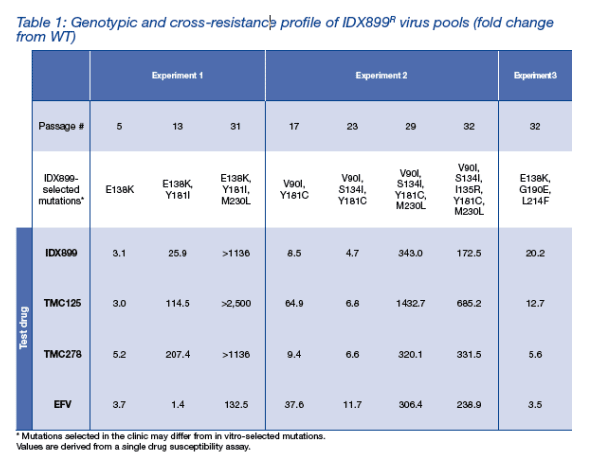
· High level resistance to IDX899 emerged slowly (≥ 29 passages).
· IDX899 selected 2 independent resistance pathways4 initiated by mutations at:
-- E138K, or
-- V90I and Y181C
Most (5/8) IDX899 virus pools exhibited moderate to high level resistance to IDX899.
EFV retained the best overall activity against the IDX899-selected virus pools; only M230Lcontaining viruses were highly resistant to EFV (>100 fold).
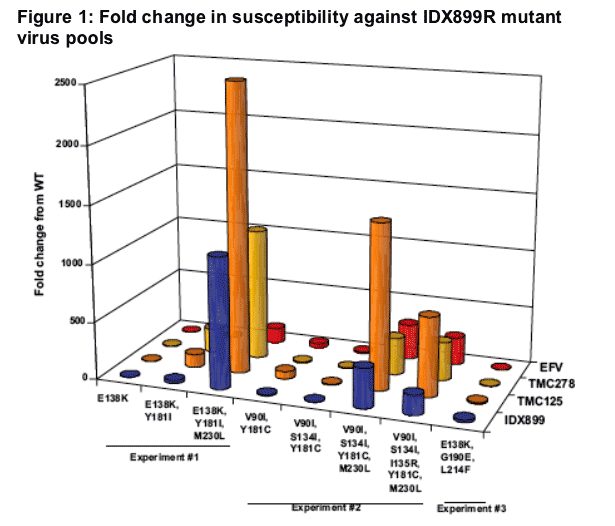
· IDX899R virus pools showed high level resistance to all tested drugs.
· Among all tested NNRTIs, EFV showed the most activity against IDX899R virus pools and had the most different cross-resistance profiles versus IDX899.
Activity of the 4 agents against EFVR virus pools
EFVR virus pools were tested against all 4 drugs. Data from representative virus pools from 2 independent selection experiments are shown in Table 2 and Figure 2.
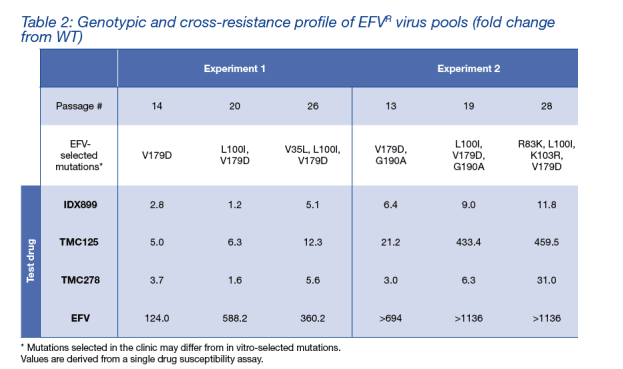
· High level (>100 fold) resistance to EFV emerged rapidly (as early as passage 6)4 and required only 1 mutation (as detected by population sequencing).
· TMC278 and IDX899 exhibited a similar cross-resistance profile and remained largely active against the EFVR virus pools.
· TMC125 showed a greater loss of susceptibility compared to TMC278 and IDX899.
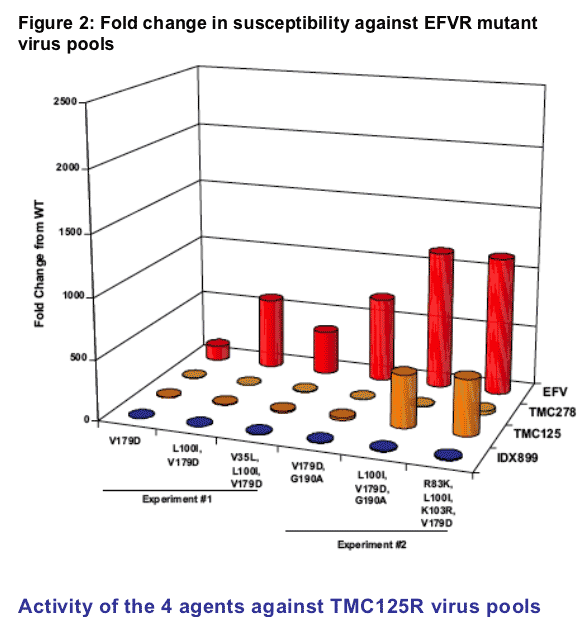
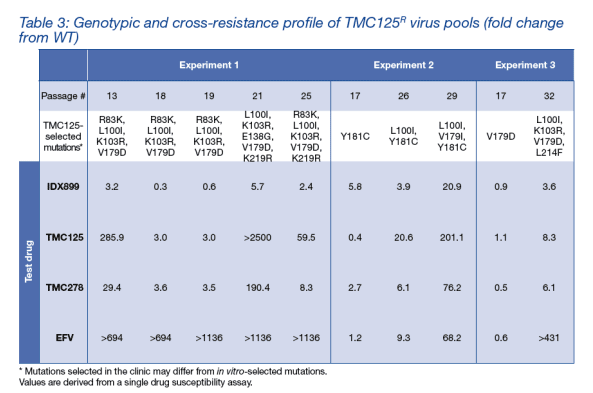
· TMC125R virus pools (with up to 5 mutations) remained largely sensitive to IDX899: only 1/10 virus pools was moderately resistant to IDX899.
· IDX899 fold-resistance against TMC125R virus pools averaged >13-fold less than that of TMC125.
· Most TMC125R virus pools were highly cross-resistant to EFV.
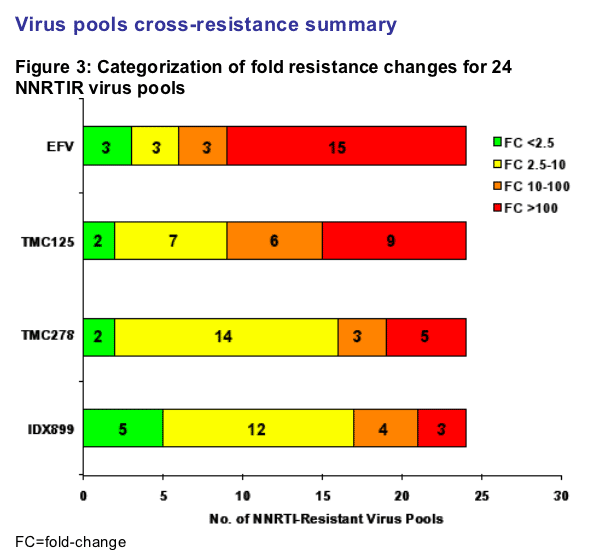
· 71% (17/24) of the 24 NNRTI-selected virus pools tested were <10-fold cross resistant to IDX899 versus 25% (6/24), 38% (9/24) and 67% (16/24) for EFV, TMC125 and TMC278, respectively.
· IDX899 and TMC278 had the best overall cross-resistance profiles.
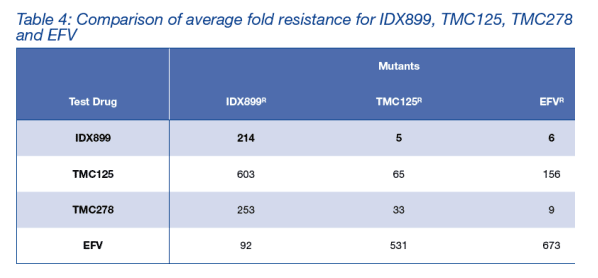
Average fold resistance for the test drug was calculated as the mean of the individual fold-shifts tested in parallel experiments.
Table summarizes the average fold-shift seen for each of the 4 drugs when tested against all virus pools selected by IDX899, TMC125 and EFV.
· TMC125 and TMC278 were not active against IDX899R virus pools.
· IDX899 was more active than TMC125 and equivalent to TMC278 against NNRTI-selected virus pools.
Antiviral activity of the 4 agents against site-directed HIV-1 mutant viruses
Table 5: Cross-resistance profiles of site-directed NNRTIR HIV-1 mutants
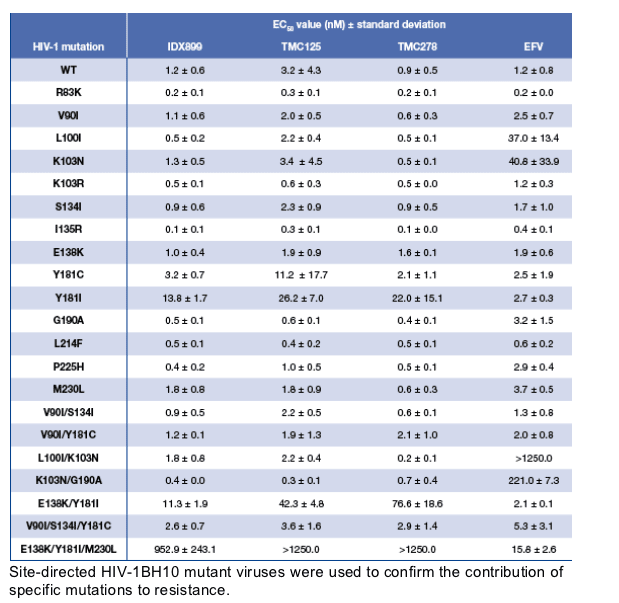
Site-directed HIV-1BH10 mutant viruses were used to confirm the contribution of specific mutations to resistance.
· The cross-resistance profile of IDX899 was generally similar to those of TMC125 and TMC278.
· Some differences are apparent compared to EFV.
· The cross-resistance profile of IDX899 against virus pools was largely confirmed with site-directed mutant viruses. However, the degree of resistance was higher in some virus pools than in the site-directed mutants presumably due to contributions from minor mutant species not detected by direct sequencing (but seen by clonal sequencing; data not shown).
· Addition of M230L to E138K/Y181I caused high level resistance to IDX899, TMC125 and TMC278, but had less effect on EFV.
References
1. Richman DD, Dousson CB, Storer R, et al (2007). 14th Conference on Retroviruses and Opportunistic Infections (CROI), Los Angeles, USA.
2. Jakubik J, Seifer M, Gray L, et al (2007). Antiviral Therapy;12:S32.
3. Idenix Pharmaceuticals, February 6th, 2008, press release.
4. Richman DD, Jakubik J, Chapron C, et al (2008). 15th Conference on Retroviruses and Opportunistic Infections (CROI), Boston, USA.
5. Mayers D, Hard N, Damphousse D, et al (2008). 15th Conference on Retroviruses and Opportunistic Infections (CROI), Boston, USA.
6. Murphy R, Zala C, Zhou XJ, et al (2008). XVII International HIV Drug Resistance Workshop, abstract #25.
|
| |
|
 |
 |
|
|